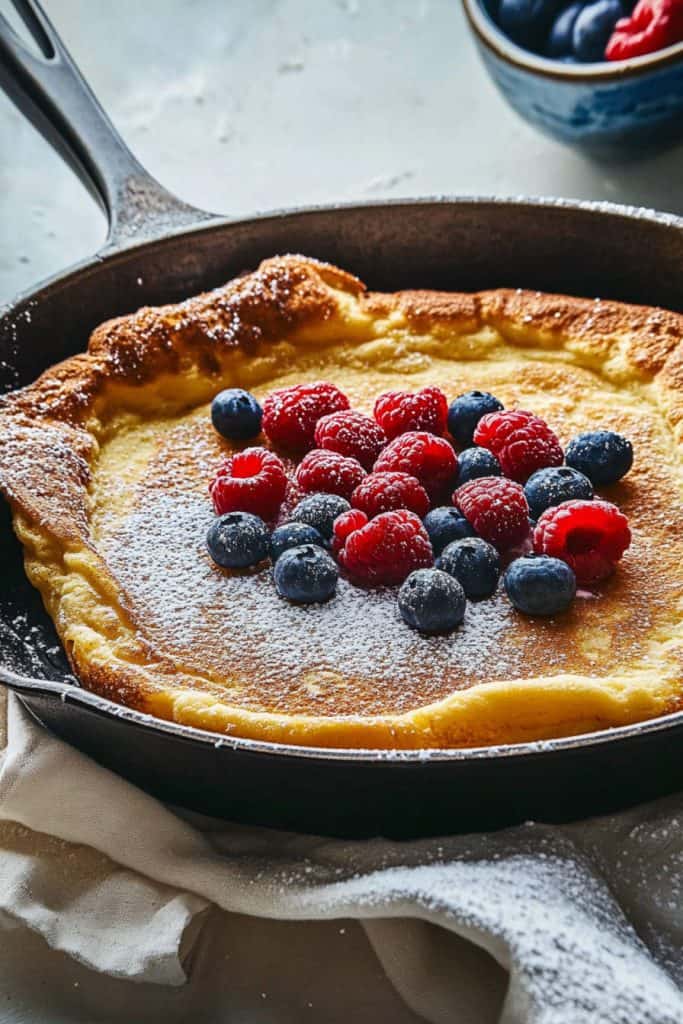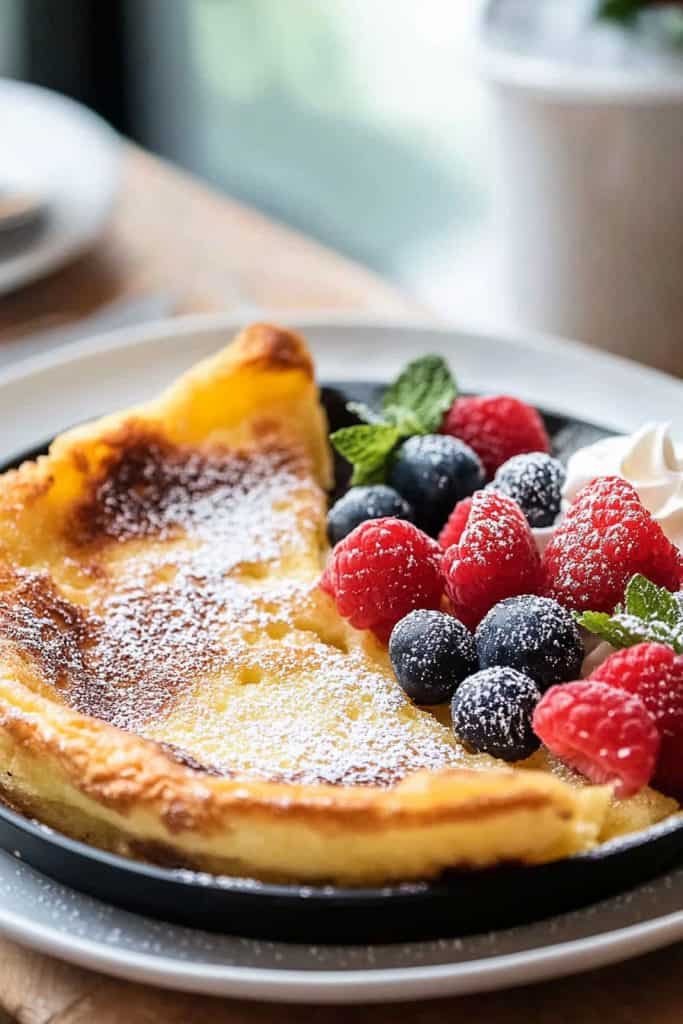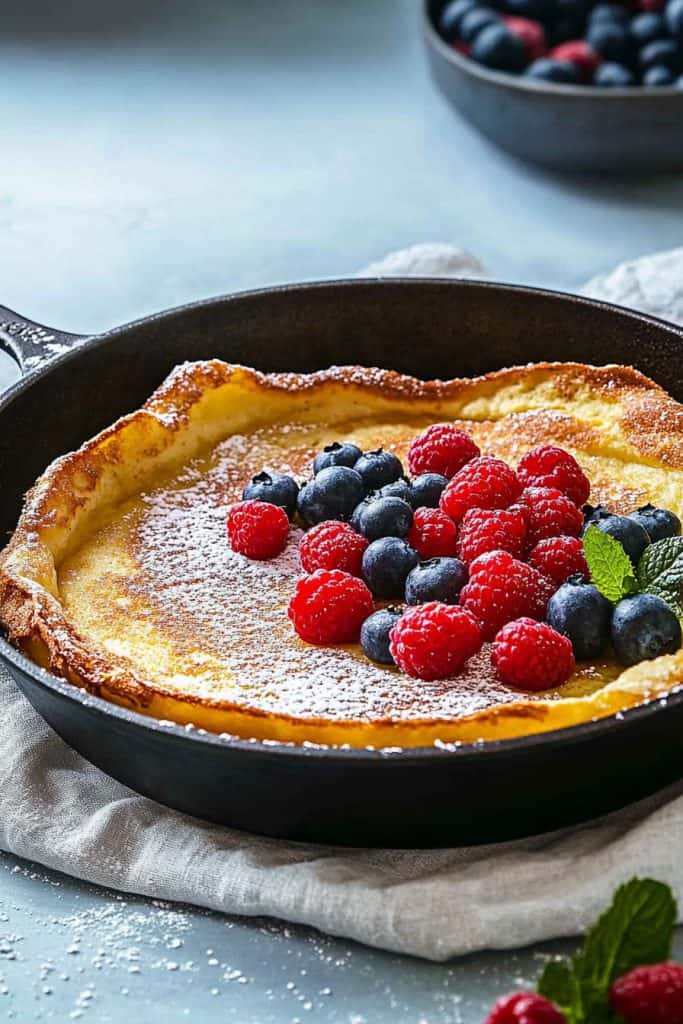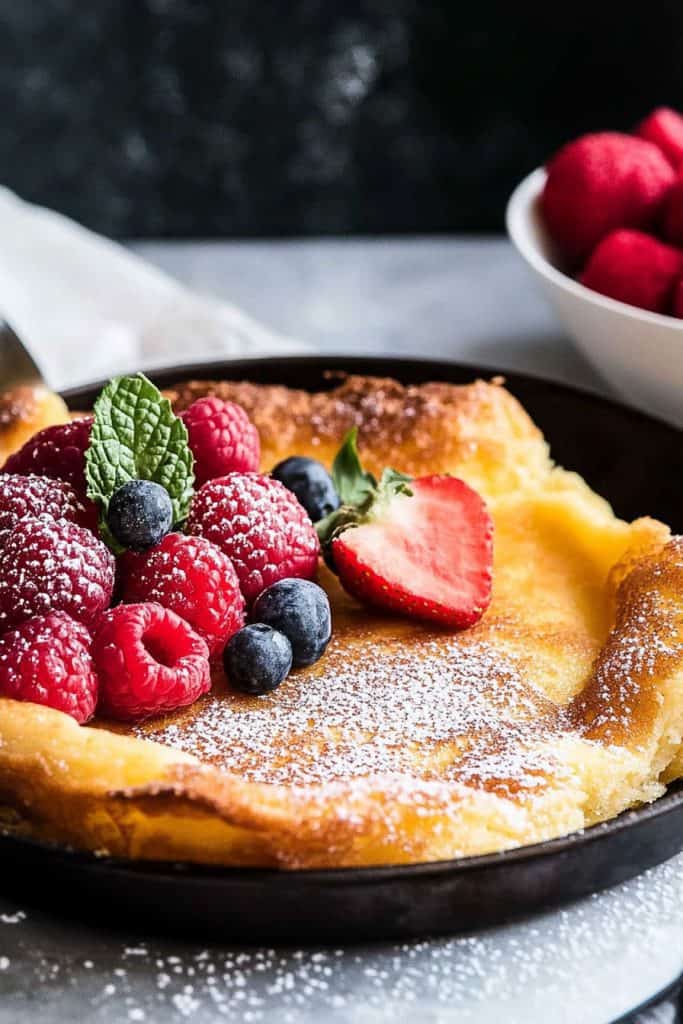Imagine waking up to the aroma of a golden, puffed-up Dutch Baby Pancake wafting through your kitchen. This delightful dish, often described as a cross between a pancake and a popover, has roots in German cuisine but found its home in American brunch culture. It’s not just a feast for the eyes; it’s incredibly versatile and easy to make.
What I love most about Dutch Baby Pancakes is their dramatic rise in the oven, creating a crispy edge and custardy center. Whether you top it with fresh berries, a dusting of powdered sugar, or a drizzle of maple syrup, this pancake is sure to impress. Perfect for a lazy Sunday morning or a special occasion, it’s a recipe that brings both comfort and a touch of elegance to your table.
What Is A Dutch Baby Pancake?
A Dutch Baby Pancake, also known as a German pancake or a Dutch puff, is a large, fluffy pancake that is baked in the oven rather than cooked on a stovetop. Its unique texture and impressive rise make it a showstopper at any breakfast or brunch table.

History Of The Dutch Baby Pancake
The Dutch Baby Pancake has its origins in Germany, where similar pancakes called “pfannkuchen” were popular. These pancakes were brought to America by German immigrants and eventually evolved into the larger, dramatic version we enjoy today. The term “Dutch Baby” was coined in the early 1900s by a Seattle restaurant called Manca’s Cafe, adding a unique American twist to this classic dish.
Difference Between Dutch Baby and German Pancakes
While a Dutch Baby Pancake and a traditional German pancake share roots and some similarities, there are key differences. A German pancake, or pfannkuchen, is typically thinner and cooked on the stovetop, resembling more of a crepe. Conversely, a Dutch Baby Pancake is thicker, with a puffed-up, airy texture from being baked at high heat in the oven. This cooking method gives the Dutch Baby its signature crispy edges and custardy center.
Ingredients
The beauty of Dutch Baby Pancakes lies in their simplicity. Using a handful of basic ingredients, you can create a show-stopping dish that is adaptable to various toppings and flavors.
Main Ingredients
- 3 large eggs: Room temperature
- 1/2 cup all-purpose flour: Sifted
- 1/2 cup whole milk: Room temperature
- 1 tbsp granulated sugar
- 1 tsp vanilla extract
- 1/4 tsp salt
- 2 tbsp unsalted butter: Melted
- Powdered sugar: For dusting
- Fresh berries: Blueberries, raspberries, strawberries
- Lemon wedges: For a citrus zing
- Maple syrup: For a classic touch
- Whipped cream: Adds creaminess
- Nutella: For a chocolatey delight
- Toasted nuts: Almonds, pecans, or walnuts for added crunch
- Cinnamon and sugar: A sprinkle for extra flavor
Recommended Tools and Equipment
To make the perfect Dutch Baby Pancake, having the right tools and equipment is essential. Here are my top recommendations for achieving ideal results.
Cast Iron Skillet
A cast iron skillet is my top choice for baking Dutch Baby Pancakes. Its excellent heat retention and even cooking surface are key for producing those signature crispy edges. I recommend using a 10 to 12-inch cast iron skillet for the best results. Make sure to preheat the skillet in the oven before pouring in the batter. This ensures the pancake rises properly and achieves a beautiful golden-brown color.
Alternative Cookware Options
If a cast iron skillet is not available, you can use other oven-safe pans. Heavy-duty stainless steel or enameled cast iron pans work well. Opt for a similar 10 to 12-inch size for even cooking. Be sure to preheat the pan in the oven, similar to the cast iron skillet. Avoid using non-stick or aluminum pans as they do not provide the same heat distribution and can affect the rise and texture of your Dutch Baby Pancake.

Make Ahead Instructions
Making Dutch Baby Pancakes ahead of time can save you valuable moments during busy mornings. With a few simple steps, you can store and reheat your pancakes beautifully.
Storing Batter
To store the batter:
- Mix the batter thoroughly following the recipe instructions.
- Transfer the batter to an airtight container.
- Refrigerate for up to 24 hours for best results.
When you’re ready to cook:
- Preheat your oven and skillet as usual.
- Give the batter a quick stir to ensure even consistency.
- Pour the batter into the preheated skillet and bake as directed.

Freezing and Reheating Tips
For freezing and reheating:
- Freeze:
- Allow baked Dutch Baby Pancakes to cool completely.
- Wrap each pancake tightly in plastic wrap, then in aluminum foil.
- Store in a freezer-safe bag or container for up to 2 months.
- Reheat:
- Preheat your oven to 350°F (175°C).
- Remove the plastic wrap and aluminum foil.
- Place the pancakes on a baking sheet and cover with aluminum foil to retain moisture.
- Bake for 10-15 minutes until warmed through.
These steps ensure your Dutch Baby Pancakes retain their delightful texture and taste, making breakfast prep a breeze.
How to Make Dutch Baby Pancakes
Creating the perfect Dutch Baby Pancakes requires careful preparation and a few essential steps. This guide will walk you through each stage, ensuring you achieve the ideal fluffy and golden results.
Prep Steps
- Preheat the Oven: Set your oven to 425°F (220°C). Place a 10-inch cast iron skillet inside to heat up as well.
- Gather Ingredients: Organize all necessary ingredients on your countertop for easy access.
- Room Temperature Ingredients: Ensure your eggs and milk are at room temperature to help the batter mix smoothly.
Mixing the Batter
- Whisk the Eggs: In a large bowl, whisk 3 large eggs until frothy.
- Add the Milk: Gradually add ¾ cup whole milk, whisking continuously.
- Incorporate Dry Ingredients: Sift ½ cup all-purpose flour, 1 tablespoon sugar, and ½ teaspoon salt directly into the bowl. Continue whisking until the batter is smooth and lump-free.
- Add Vanilla: Stir in 1 teaspoon vanilla extract for extra flavor.

Baking Instructions
- Melt Butter: Once the oven is preheated, carefully remove the hot skillet. Add 2 tablespoons unsalted butter and swirl it to coat the bottom and sides.
- Pour the Batter: Quickly pour the prepared batter into the skillet, ensuring it spreads evenly.
- Bake: Place the skillet back in the oven. Bake for 20-25 minutes until the pancake is puffed and golden brown around the edges.
- Serve Immediately: Remove from the oven and cut into wedges. Top with powdered sugar, fresh berries, or syrup as desired.
- Pancake Not Puffing Up: Ensure your skillet and oven are fully preheated. Cold pans prevent proper puffing.
- Batter Lumps: Using room temperature ingredients and adequate whisking minimizes lumps.
- Burned Edges: Monitor the baking time closely. Every oven varies, so adjust accordingly to avoid overbaking.
Serving Recommendations
Whether enjoying a leisurely brunch or a quick breakfast treat, Dutch Baby Pancakes shine with the right accompaniments. Below are my top recommendations for toppings and side dishes.
Best Toppings
A Dutch Baby Pancake’s versatile flavor profile makes it the perfect canvas for various toppings. Here are my favorites:
- Powdered Sugar: A light dusting adds the perfect touch of sweetness.
- Fresh Berries: Strawberries, blueberries, or raspberries add a burst of color and natural sweetness.
- Lemon Juice and Zest: A squeeze of fresh lemon juice and a sprinkle of zest give a refreshing tang.
- Maple Syrup: Classic and always satisfying, adding a rich, caramelized sweetness.
- Sliced Fruits: Bananas, peaches, or apples offer additional texture and flavor variety.
- Whipped Cream: Light and airy, complementing the warm pancake beautifully.
- Nuts or Seeds: Toasted almonds, walnuts, or chia seeds bring a delightful crunch.
- Nutella or Chocolate Sauce: For those with a sweet tooth, drizzled Nutella or chocolate syrup makes it a decadent treat.

Side Dishes to Pair With
To round out your meal, consider these complementary side dishes that balance and enhance the experience:
- Crispy Bacon: The salty, smoky flavor of bacon pairs perfectly with the pancake’s sweet elements.
- Sausage Links: A savory option that adds protein and contrasts nicely with sweet toppings.
- Fresh Fruit Salad: A vibrant, refreshing medley of seasonal fruits.
- Yogurt: Creamy and tangy, a bowl of Greek yogurt pairs well with the pancake.
- Scrambled Eggs: Light, fluffy eggs add a comforting, classic breakfast component.
- Hash Browns: Crispy and golden, they bring a satisfying, savory crunch.
- Smoked Salmon: A sophisticated and savory option that pairs exceptionally well with lemon and herb toppings on the Dutch Baby.
With these toppings and side dishes, you can transform a simple Dutch Baby Pancake into an extraordinary culinary experience.
Conclusion
Dutch Baby Pancakes offer a delightful and versatile option for any meal. With their simple ingredients and the right skillet, they’re easy to prepare and always impressive. Whether you’re a seasoned cook or a beginner, mastering this recipe can bring a touch of culinary magic to your kitchen. Don’t forget to experiment with various toppings and sides to make each serving unique and memorable. Enjoy the process and happy cooking!
